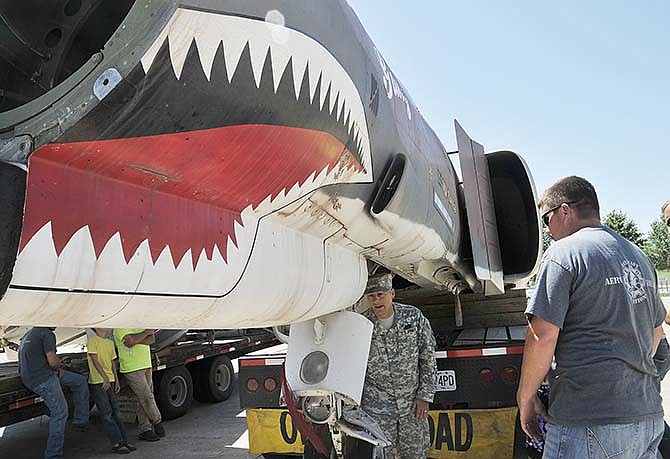When Grayson Wells went to work with his father Friday morning, his office was the cab of a semi-truck and the 11-year-old was responsible for watching out the rear view mirrors to ensure their cargo - an F-4 Phantom II fighter jet - traveled safely along U.S. 50 west from Jefferson Barracks in St. Louis to the Museum of Missouri Military History in Jefferson City.
"I never did that before; it was pretty exciting," Grayson said. "Hauling a military jet is pretty cool."
Three days earlier, Wells' father Mark and his crew of five began the process of disassembling the static display jet. With his business Aero-Relo, based in California, Missouri, Wells also has moved a C-130 Hercules and two F-16 Fighting Falcons.
The niche business was born when Wells pitched in to help move a C-130 from Texas to Kentucky in 2012. The man who had the contract arrived in a high-end luxury car with only a home repair tool box, he recalled. Soon realizing the contract-holder was in over his head, Wells jumped in and started problem-solving his way to disassembly.
Unlike the assembly and maintenance of these planes, which requires a great deal of training, the disassembling process has no manual.
Wells has learned by hit and miss, he said.
Even the mechanics and servicemen who may have worked on the exact machine for years don't have much idea how to take it apart for transport.
Since his first job, Wells said he has become more confident in how to proceed, reducing the hours required for disassembly by nearly two-thirds.
"Once you understand the principles of aircraft structure, you can feel your way through it," Wells said.
There's no cutting or breaking, because everything needs to go back together correctly.
But the highly-engineered crafts have tight tolerances, leaving few options for carefully removing piece by piece, Wells said.
The F-4 Rose's Gang was disassembled in about four days at Jefferson Barracks, St. Louis, and prepared for its journey westward along U.S. 50 on Friday. One truck carried the long, slender fuselage and another carried the 22-by-38-foot, single-piece wing.
Traveling through the city of Linn was the only real concern on the road, with the exception of distracted drivers, Wells said.
"Today, it's a lot scarier than it was 10 years ago," he said.
Aero-Relo is certified to move only static airplanes, basically "lawn ornaments," Wells said.
Static planes have been demilitarized, meaning the weapons system, avionics, ejection seats and engine have been removed.
But the remaining hydraulic and fuel system still create potential challenges.
"We're always at the mercy of the plane," Wells said. "You don't know its history."
Fatigue or warping can add time and frustration to the dismantling.
But this F-4 "was a real joy," he said. He penciled in 10 days, but it only took his crew of five three days.
"We're pretty good about going into things blind and learning by default," Wells said. "I enjoy a challenge and never have been one to do what everybody else is doing."
Only one other company in the United States does this kind of work, he said. So he's hoping to grow the business in the future.
Wells and his crew will put the F-4 back together next week at the museum. Generally, small crowds gather to watch Aero-Relo work, he said. He particularly enjoys when veterans come out and tell their stories.
"We want everybody to have a good experience," Wells said.
But there's a sad element, too. Most of the planes Aero-Relo moves have been at a location for some time, and people there have grown attached to it. So, while one site gains, another loses.
Moving this F-4 from St. Louis to Jefferson City, by far, has been the closest job to home for Wells. The museum has waited more than a year for the jet to arrive.
"Our excitement comes from sharing it with the people we're moving it for," Wells said.
Related article:

